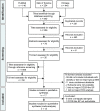Striatal dopamine D2-like receptors availability in obesity and its modulation by bariatric surgery: a systematic review and meta-analysis
- PMID: 36973321
- PMCID: PMC10042861
- DOI: 10.1038/s41598-023-31250-2
Striatal dopamine D2-like receptors availability in obesity and its modulation by bariatric surgery: a systematic review and meta-analysis
Abstract
There is significant evidence linking a 'reward deficiency syndrome' (RDS), comprising decreased availability of striatal dopamine D2-like receptors (DD2lR) and addiction-like behaviors underlying substance use disorders and obesity. Regarding obesity, a systematic review of the literature with a meta-analysis of such data is lacking. Following a systematic review of the literature, we performed random-effects meta-analyses to determine group differences in case-control studies comparing DD2lR between individuals with obesity and non-obese controls and prospective studies of pre- to post-bariatric surgery DD2lR changes. Cohen's d was used to measure effect size. Additionally, we explored factors potentially associated with group differences in DD2lR availability, such as obesity severity, using univariate meta-regression. In a meta-analysis including positron emission tomography (PET) and single-photon emission computed tomography (SPECT) studies, striatal DD2lR availability did not significantly differ between obesity and controls. However, in studies comprising patients with class III obesity or higher, group differences were significant, favoring lower DD2lR availability in the obesity group. This effect of obesity severity was corroborated by meta-regressions showing inverse associations between the body mass index (BMI) of the obesity group and DD2lR availability. Post-bariatric changes in DD2lR availability were not found, although a limited number of studies were included in this meta-analysis. These results support lower DD2lR in higher classes of obesity which is a more targeted population to explore unanswered questions regarding the RDS.
© 2023. The Author(s).
Conflict of interest statement
GR, AM, GC, FPMO, DCC did not report conflicts of interest. AJO-M was the national coordinator for Portugal of a non-interventional study (EDMS-ERI-143085581, 4.0) to characterize a Treatment-Resistant Depression Cohort in Europe, sponsored by Janssen-Cilag, Ltd (2019–2020), of a trials of psilocybin therapy for treatment-resistant depression, sponsored by Compass Pathways, Ltd (EudraCT No. 2017-003288-36), and of a trial of esketamine for treatment-resistant depression, sponsored by Janssen-Cilag, Ltd (EudraCT No.: 2019-002992-33), and is a recipient of a grant from Schuhfried GmBH for norming and validation of cognitive tests.
Figures





Similar articles
-
Postingestive reward acts through behavioral reinforcement and is conserved in obesity and after bariatric surgery.PLoS Biol. 2024 Dec 17;22(12):e3002936. doi: 10.1371/journal.pbio.3002936. eCollection 2024 Dec. PLoS Biol. 2024. PMID: 39689052 Free PMC article.
-
Striatal dopamine D2/3 receptor availability increases after long-term bariatric surgery-induced weight loss.Eur Neuropsychopharmacol. 2016 Jul;26(7):1190-200. doi: 10.1016/j.euroneuro.2016.04.009. Epub 2016 May 12. Eur Neuropsychopharmacol. 2016. PMID: 27184782
-
Brain dopamine and obesity.Lancet. 2001 Feb 3;357(9253):354-7. doi: 10.1016/s0140-6736(00)03643-6. Lancet. 2001. PMID: 11210998
-
Dopamine in major depressive disorder: A systematic review and meta-analysis of in vivo imaging studies.J Psychopharmacol. 2023 Nov;37(11):1058-1069. doi: 10.1177/02698811231200881. Epub 2023 Oct 9. J Psychopharmacol. 2023. PMID: 37811803 Free PMC article.
-
Similarity between obesity and drug addiction as assessed by neurofunctional imaging: a concept review.J Addict Dis. 2004;23(3):39-53. doi: 10.1300/J069v23n03_04. J Addict Dis. 2004. PMID: 15256343 Review.
Cited by
-
Central dopamine receptors: Radiotracers unveiling the Role of dopaminergic tone in obesity.J Mol Med (Berl). 2025 Jan;103(1):21-32. doi: 10.1007/s00109-024-02501-0. Epub 2024 Dec 4. J Mol Med (Berl). 2025. PMID: 39630278 Free PMC article. Review.
-
Smoking, Obesity, and Post-Cessation Weight Gain: Neurobiological Intersection and Treatment Recommendations.J Multidiscip Healthc. 2025 May 24;18:2889-2900. doi: 10.2147/JMDH.S509971. eCollection 2025. J Multidiscip Healthc. 2025. PMID: 40438565 Free PMC article. Review.
-
In Silico Pharmacogenomic Assessment of Glucagon-like Peptide-1 (GLP1) Agonists and the Genetic Addiction Risk Score (GARS) Related Pathways: Implications for Suicidal Ideation and Substance Use Disorder.Curr Neuropharmacol. 2025;23(8):974-995. doi: 10.2174/011570159X349579241231080602. Curr Neuropharmacol. 2025. PMID: 39865816 Free PMC article.
-
Genetic Correlates as a Predictor of Bariatric Surgery Outcomes after 1 Year.Biomedicines. 2023 Sep 27;11(10):2644. doi: 10.3390/biomedicines11102644. Biomedicines. 2023. PMID: 37893019 Free PMC article.
-
PET/fMRI demonstrates that bariatric surgery may reverse striatal dopaminergic dysfunction in women with obesity.Commun Med (Lond). 2025 Aug 28;5(1):375. doi: 10.1038/s43856-025-01079-z. Commun Med (Lond). 2025. PMID: 40877587 Free PMC article.
References
-
- O’Brien PE, et al. Long-term outcomes after bariatric surgery: a systematic review and meta-analysis of weight loss at 10 or more years for all bariatric procedures and a single-centre review of 20-year outcomes after adjustable gastric banding. Obes. Surg. 2019;29:3–14. doi: 10.1007/s11695-018-3525-0. - DOI - PMC - PubMed
Publication types
MeSH terms
Substances
LinkOut - more resources
Full Text Sources
Medical

